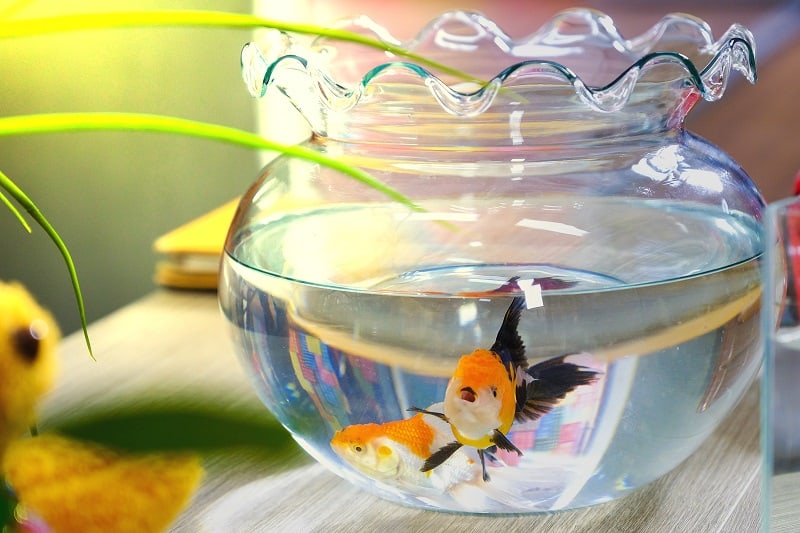Whether you’re a beginner, intermediate, or expert at all things aquarist, there will come a time when you are faced with questions you may not know the answers to. One of these questions will likely center on if air fresheners can kill the fish in your aquarium. When evaluating the overall health of your tank and fish, this is perhaps one of the most important questions you need to answer.
Most air fresheners contain additives that are harmful to humans, animals, and aquatic life. It has been proven by experts in the marine industry that air fresheners kill fish due to the toxic chemicals present. These chemicals often make their way into an aquarium’s water supply, poisoning fish tank’s
With your suspicions concerning air fresheners now confirmed, let’s take a look at ways you can prevent this from happening to your own fish. This article will discuss how air freshener affects fish, how pollutants compromise aquariums, how to identify if your fish has been poisoned, and products to avoid.

How Does Air Freshener Affect Fish?
The chemicals present in air fresheners, plug-in fresheners, oil diffusers, and spray bottles vary. Yet, many of these chemicals can lead to different degrees of harm to your aquatic life. Some of the more widely used chemicals are Asphenols, Phenylpropanes, Monoterpene Hydrocarbons, and Ketones.
These four chemicals are highly toxic to tank life and should be avoided whenever possible. They should be avoided because once they have been released into the air, they sit on the surface of your tank’s water, leaving a residue that often contaminates aquatic life.
These chemicals then make their way into the gills of your fish as they disperse throughout your filtration system, causing oxygen deprivation and even suffocation if left untreated. Moreover, this chemical residue on the surface will prevent oxygen from entering and prevent other gasses from escaping. Chemical residues will also cause further problems, such as algae blooms within your aquarium.
Different Kinds Of Air Freshener
With so many types of air freshener available on the market today, it is essential to check the labeling. By checking the labeling, you will be able to identify the ingredients present within an air freshener. Thus you ensure that if there are chemicals present, they won’t have any adverse effects on your aquatic life. However, most marine hobbyists agree that the majority of air fresheners on the market contain harmful chemicals.
When these air fresheners are diffused or sprayed into a room where a fish tank is, the results are usually dangerous. Often any fish within a tank will become sick or die.
Below is a list of air freshener types that usually contain harmful chemicals commonly used amongst individuals and aquarists alike.
- Plug-in air freshener
- Aerosol cans
- Renuzit-type fresheners
- Diffusers
- Misters
- Scented candles
How Pollutants Compromise Aquariums
When it comes down to pollutants, there are three main ways in which airborne pollutants found within air fresheners can alter the delicate chemical balance within your tank and kill your fish. Pollutants can adjust the oxygen and Ph of your water. Additionally, large amounts of toxic compounds can become present in your tank. We have listed exactly how these aspects are affected by pollutants below in more detail.
Oxygen
For your aquarium to function correctly, there needs to be an exchange of gasses from within your tank through the water’s surface. With the help of a fish tank’s wavemaker and return pump, the water’s surface is agitated. This action allows oxygen to be absorbed and for other gasses such as Carbon Dioxide and Nitrogen to be expelled.
The water’s surface is the first point of contact for any airborne pollutant found in air fresheners. Some contaminants can produce an oily film on the surface, preventing oxygen from being absorbed and gasses from being exchanged even with the assistance of a tank’s wavemaker and pump. Additionally, keep in mind that other pollutants act oppositely, pulling the oxygen from the water via a chemical reaction. Both an oily film and oxygen being removed from a tank’s water will result in making your fish sick or killing them.
Fluctuating Ph Levels
From dusk to dawn your aquarium experiences its most significant Ph fluctuation. This is because many people indulge with candles, air fresheners, or oils in the evening, making it more likely that your tank will experience a negative Ph change.
Once the lights are off, the algae and coral can no longer photosynthesize and produce oxygen from the Carbon Dioxide. Throughout the night, the oxygen levels consumed increase along with the amount of Carbon Dioxide released into the water. Because of this, the overall Ph of the water decreases.
When a chemical pollutant is released within the vicinity of your fish tank, it aids in the consumption, conversion, or reduction of oxygen, which further causes the Ph to fluctuate rapidly. As a result, you could have dead fish in your aquarium by morning.
Toxic Compounds
The most significant way to alter the balance within your tank is by having a chemical concentration so great that it begins to destroy the cells within the fish. For instance, some essential oil air fresheners can cause damage to the liver or even death via liver failure from prolonged exposure. As is the case with toxic substances in an enclosed space, if it is not removed with all haste, then your fish, plant life, or crustaceans could face irreparable damage.
How To Check If Your Fish Has Been Poisoned and Tips To Prevent Water Poisoning
How To Check If Your Fish Has Been Poisoned By Air Freshener
To know what signs to be on the lookout for in your tank, you must first be willing to conduct a few tests. These tests are specifically designed to assist you in evaluating your tank’s overall health and correct any problems that may have arisen. Listed below are the four steps you will need to gauge whether or not your fish have been poisoned.
- Firstly you will need to perform an investigation into the overall appearance of your tank. Begin with asking yourself some critical questions.
- Are your fish gasping at the surface?
- Is the tank cloudy?
- Do you have one dead fish or multiple?
- Does the tank water smell rancid?
- Is there any residue present on the surface of the water?
- Are there fish lying on the sandbed?
- Are the invertebrates dead and not the fish?
If all your fish were healthy and active in their tank and then suddenly died, it is most often due to environmental poisoning.
- Look for signs of disease, i.e., cloudy eyes, fin rot, gasping, or white spots. These are all signs of illness caused by air fresheners and should be diagnosed and treated accordingly. Diseased fish will almost always present with symptoms days or weeks before they die.
- Next, you will need to evaluate your findings from step one. Ask yourself and those around your tank to check for any accidental spills that may have occurred. Additionally, ask and check if any cleaning has taken place near the vicinity of your tank with the use of harsh chemicals. Moreover, ask yourself if you did anything differently today than yesterday concerning your tank. For instance, did you use a bucket you wouldn’t usually use to change your water, or have you installed a new type of air freshener?
- Following step three, you will need to test to check for any apparent changes in salinity, temperature, or equipment failures, e.g., pumps, aerators, and heaters. This is because a defective heater can cause your water to overheat or drop to dangerous levels harming your aquatic life. Additionally, you will also need to check your water parameters, i.e., Ammonia levels, Oxygen levels, Ph and Nitrate levels. Many outside factors, including air fresheners, can negatively disturb these levels. You will need to act accordingly should anything need to be corrected with the water chemistry.
Note: If invertebrates are dead and not fish, test for copper levels within your tank, as it is unlikely that they died due to chemical exposure from air fresheners.
Tips To Prevent Air Freshener Fish Tank Water Poisoning
- Research airborne fragrances or cleaners that are safe to use around fish with natural ingredients that will not cause adverse side effects.
- Limit spraying your favorite household and body fragrances to a specific room away from your aquarium.
- Swap out aerosols with pastes and creams.
- Keep the room that your fish tank is in well ventilated.
- Use high-quality activated carbon that is changed frequently to keep toxins bound in the carbon filter and out of your tank’s water.
- Use roller mats, socks, or floss to remove any solid parts of a chemical pollutant that may have occurred due to an air freshener from the water. You can do this by gently sweeping the mat, sock, or floss over the impurity and moving it to one side of the tank until you are ready to change the water.
- Educate household members or caretakers that most cleaning products and air fresheners are unsuitable or safe for use in or around aquariums.
- In addition to labeling buckets for aquarium use only, check buckets and nets for signs of soap or other chemical residues that may be present.
Products To Avoid
To ensure that your fish are thriving, healthy, and happy, it is crucial to avoid all products listed or similar to those listed below. Additionally, if you have determined that a toxin or poison has potentially entered your aquarium, the best thing to do is conduct a significant water change of at least 50 percent as soon as possible.
When doing this, be sure to add in fresh, clean water with a new activated carbon or other absorbent resin or filter to reduce the level of toxins in your tank.
- All commercially sprayed glass cleaners like Windex.
- Any carpet or upholstery cleaner similar to Febreze.
- All automated scent spray devices such as Glade plug-ins.
- Certain scented candles.
- Certain spray perfumes, lotions, or hand creams.
- Most types of aerosol and chemical pump spray that release vapors.
Safe Air Fresheners To Use
Although most air fresheners are hazardous to your fish, there are a few alternatives that you can use instead. Yet, keep in mind that not every option listed below will work for every aquarium ecosystem. That’s why you need to ensure you always examine the ingredients within the air freshener products you purchase before using them in the room where you store your fish tank.
- Eco-friendly scented candles.
- Eco-friendly reed diffusers.
- Water-based eco-friendly scented mists and spritzers.
- Certain Airwick plug-ins.
- Certain natural interior dehumidifiers.
Note: Many aquarium owners have used the above air fresheners without adverse side effects to their fish. However, it’s best to consult with an aquarium professional and do your research. Additionally, have a look for a specific fish safe label.
Read more:
